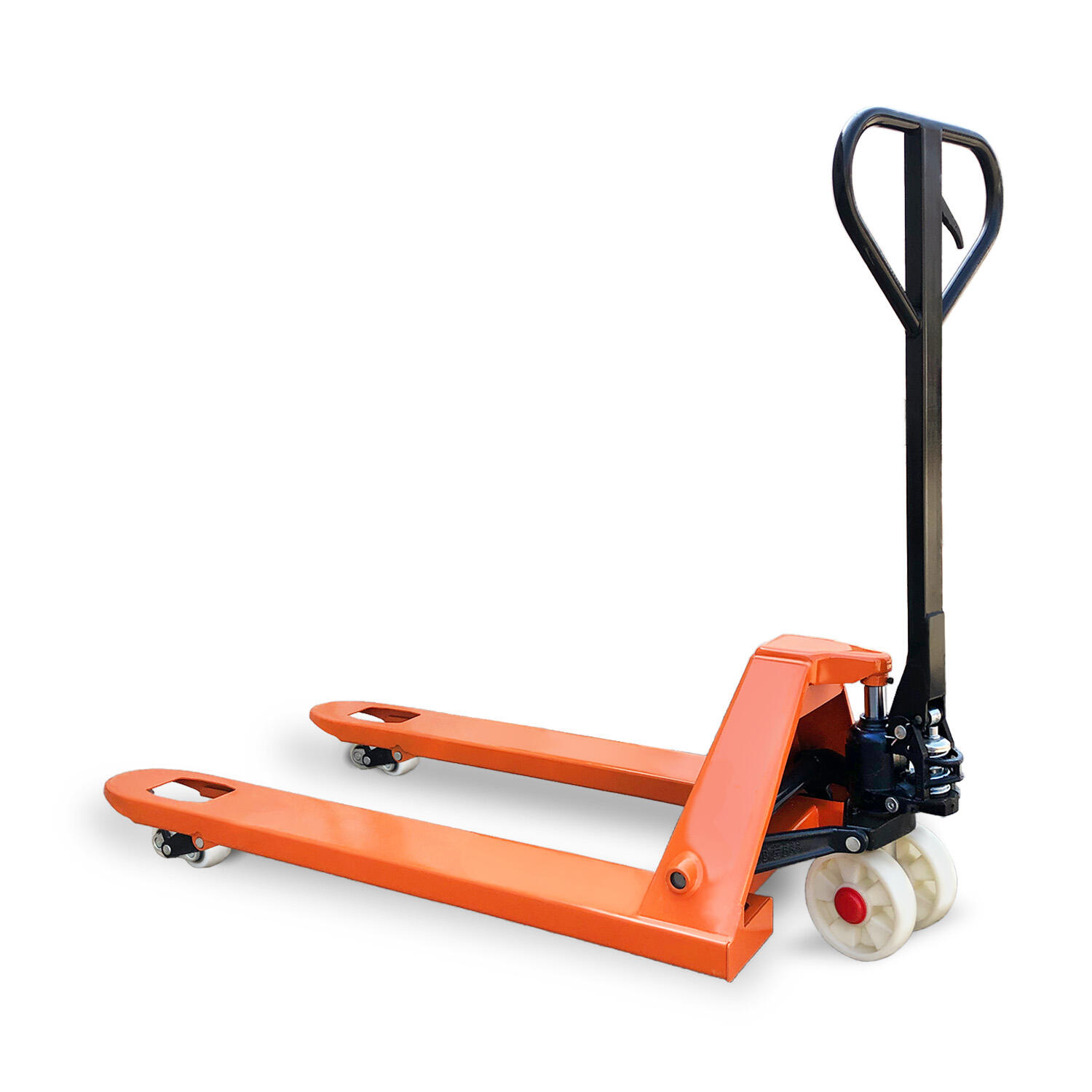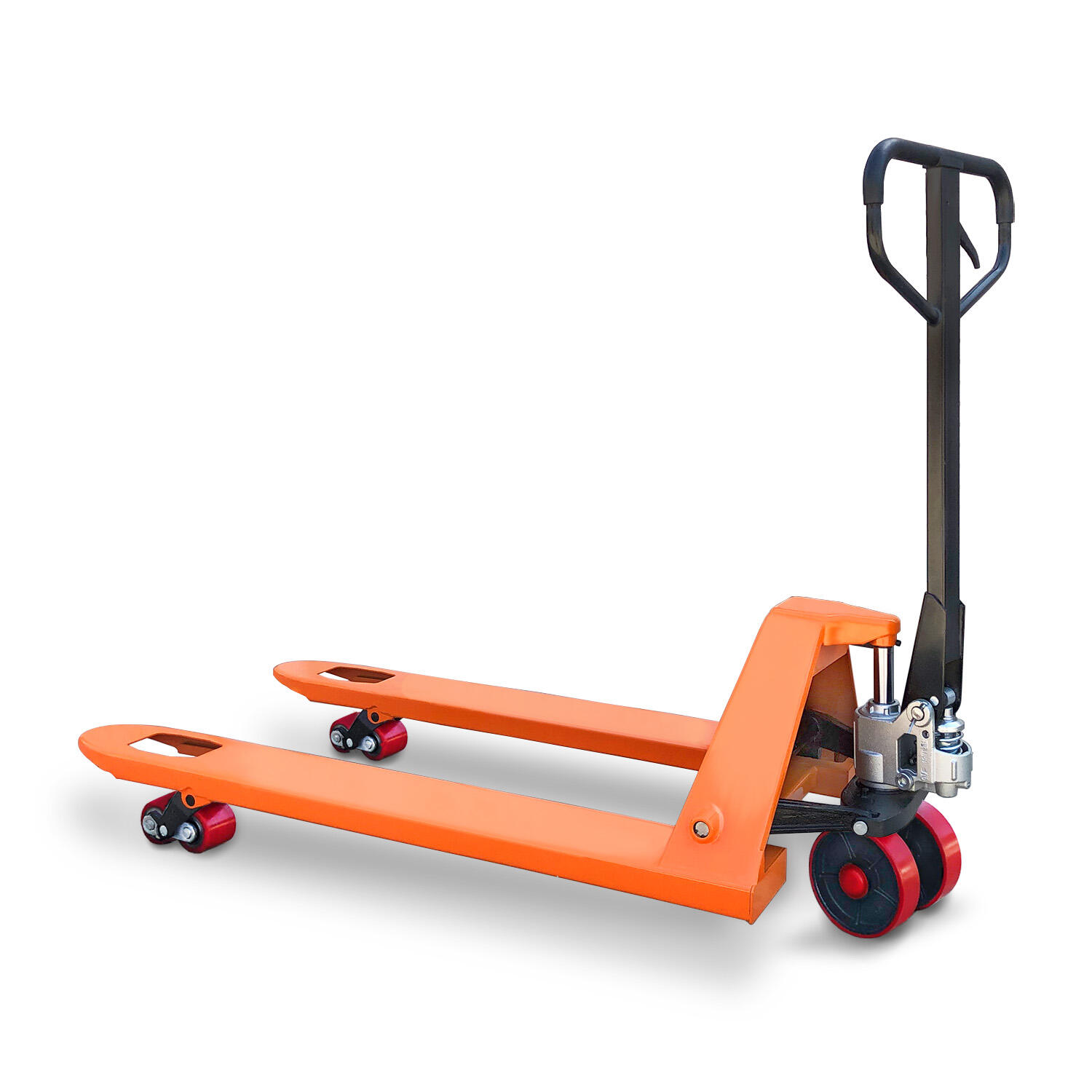A manual pallet truck, also known as a pallet jack, is an essential material handling tool designed to move and lift palletized loads with manual operation, widely used in warehouses, distribution centers, retail stores, and manufacturing facilities. Its simple yet effective design makes it a cost-efficient solution for businesses of all sizes, enabling the easy transportation of heavy goods without relying on power sources. With a focus on durability, maneuverability, and operator safety, the manual pallet truck has become a cornerstone of efficient logistics and inventory management. The construction of a manual pallet truck is centered around a robust steel frame that provides the strength to support heavy loads, typically ranging from 1,500 kg to 3,000 kg. This frame is engineered to withstand the daily stresses of industrial use, including frequent impacts, heavy loads, and exposure to various environmental conditions. The forks, which are integral to the truck, are made from high-grade steel, designed to slide smoothly under pallets and remain rigid under pressure. They are usually spaced to fit standard pallet sizes (e.g., 48x40 inches), but many models offer adjustable fork widths to accommodate non-standard pallets, skids, or containers, enhancing versatility. The lifting mechanism of a manual pallet truck is powered by a hydraulic system operated via a hand pump. When the operator pumps the handle, hydraulic fluid is forced into a cylinder, raising the forks to a height sufficient to clear the ground—typically 5 to 15 centimeters. This allows the pallet to be moved freely without scraping the floor. The lowering process is controlled by a release valve, which slowly releases hydraulic fluid to lower the forks in a controlled manner, preventing sudden drops that could damage the load or cause instability. This hydraulic system is designed to be reliable, with sealed components to prevent leaks and ensure consistent performance over time. Maneuverability is a key feature of a manual pallet truck, thanks to its compact design and efficient wheel system. It is equipped with four wheels: two small swivel casters at the front for easy turning and two larger fixed wheels at the rear for stability. The wheels are made from high-quality materials such as polyurethane or rubber, which provide a smooth ride over concrete, asphalt, and other surfaces while reducing noise and preventing floor damage. This allows operators to navigate through narrow aisles, tight corners, and crowded spaces with precision, making it ideal for use in busy warehouses and retail environments where space is limited. Ergonomics is prioritized in the design of a manual pallet truck to reduce operator fatigue and minimize the risk of injury. The handle is ergonomically shaped with a comfortable grip, often covered in rubber or foam to prevent slipping and reduce hand strain. It is positioned at a height that allows operators to stand upright, avoiding the need to bend or stoop, which can lead to back injuries during extended use. The pumping action required to lift the load is designed to be efficient, with a balanced leverage system that minimizes the effort needed to raise heavy weights. Some models feature a foldable handle, making storage more convenient when the truck is not in use. Safety is a critical aspect of the manual pallet truck’s design, with several features integrated to protect operators and loads. A key safety feature is the overload protection valve, which prevents the truck from lifting loads exceeding its rated capacity, reducing the risk of structural failure. The lowering valve is designed to control the descent of the forks slowly and evenly, preventing sudden drops. Many models include a parking brake that can be engaged to secure the truck in place during loading or unloading, preventing accidental movement. The wide base of the truck and stable wheel configuration minimize the risk of tipping, even when carrying uneven loads. Additionally, the forks are designed with rounded edges to avoid damaging pallets or goods during handling. Maintenance of a manual pallet truck is straightforward, ensuring long-term reliability and performance. Regular maintenance tasks include checking the hydraulic fluid level and topping it up with the recommended fluid type if necessary. Inspecting the hydraulic hoses and seals for leaks is essential, as even small leaks can affect performance and lead to larger issues. Moving parts such as wheel bearings, pivot points, and the handle mechanism should be lubricated periodically to ensure smooth operation. Cleaning the truck regularly to remove dirt, debris, and moisture helps prevent rust and corrosion, preserving the integrity of the steel components. Unlike powered equipment, there are no electrical systems to maintain, reducing the need for specialized tools or professional servicing. The applications of a manual pallet truck are vast, making it a versatile tool across industries. In warehouses, it is used to move pallets between storage racks, loading docks, and sorting areas, streamlining inventory management. In retail, it assists in restocking shelves from storage rooms, allowing staff to efficiently transport merchandise. In manufacturing, it moves raw materials to production lines and finished products to storage or shipping areas. It is also useful in logistics for loading and unloading trucks, as it can easily maneuver within the limited space of a truck bed. Its portability and lack of power requirements make it suitable for use in outdoor settings, such as construction sites or agricultural facilities, where electricity is not readily available. Cost-effectiveness is a significant advantage of a manual pallet truck. It has a lower initial purchase price compared to electric or powered alternatives, making it accessible to small businesses and startups. With no ongoing costs for electricity, batteries, or fuel, it is also cheaper to operate. Its durability and low maintenance requirements further reduce long-term expenses, providing excellent value for money. For businesses with moderate material handling needs, a manual pallet truck offers an efficient solution that does not compromise on performance. In conclusion, a manual pallet truck is an indispensable tool for efficient and safe material handling. Its robust construction, reliable hydraulic system, ergonomic design, and ease of maintenance make it a valuable asset for businesses seeking to improve productivity and reduce workplace injuries. Whether used in a large warehouse or a small retail store, it consistently delivers reliable performance, proving its role as a fundamental piece of equipment in modern logistics and operations.


